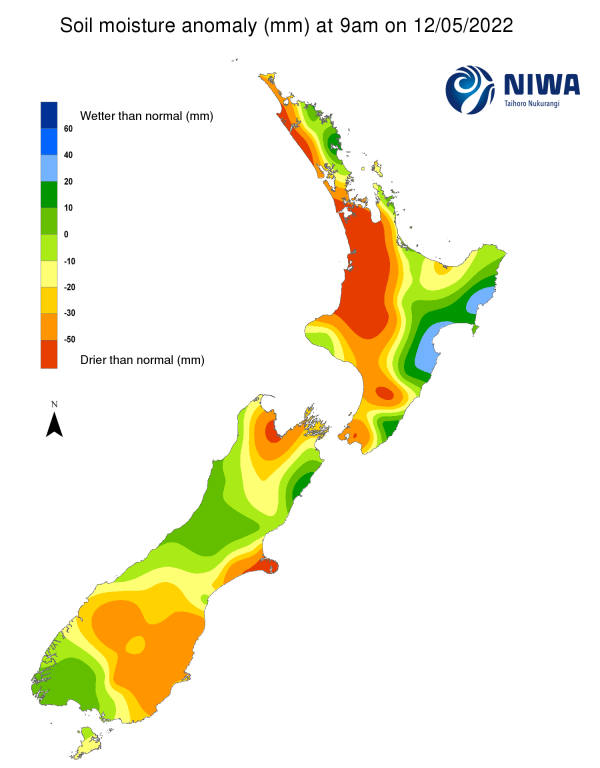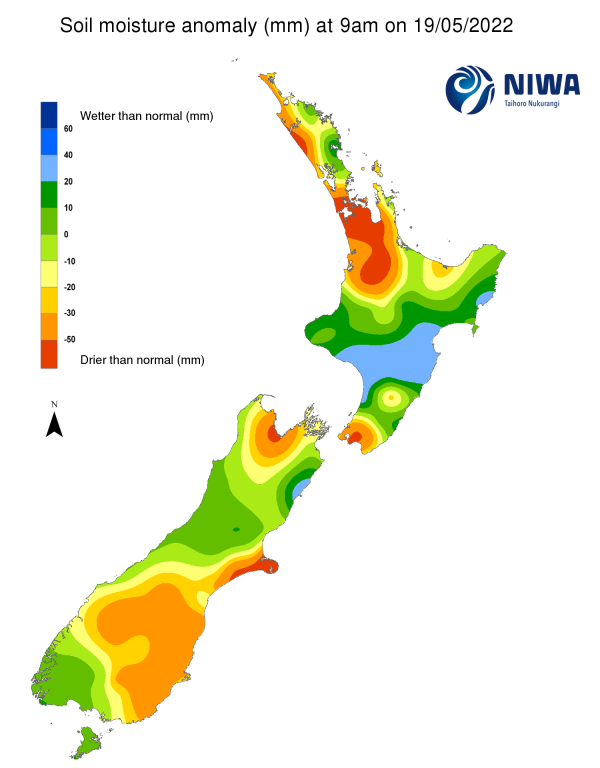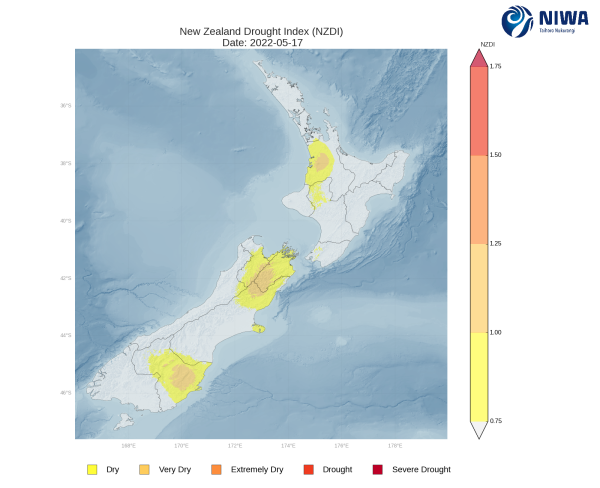A weekly update describing soil moisture patterns across the country to show where dry to extremely dry conditions are occurring or imminent. Regions experiencing significant soil moisture deficits are deemed “hotspots”. Persistent hotspot regions have the potential to develop into drought.
Please note: This will be the final update of the Hotspot Watch for this season. Weekly Hotspot Watch updates will resume in the spring.
Facts: Soil Moisture
In the North Island, western and central regions received substantial rainfall in the past week, with 50-100 mm across much of Taranaki and Manawatū-Whanganui, and up to 60 mm in Waikato and Bay of Plenty. Elsewhere, up to 25 mm was observed in the upper North Island, with slightly lower amounts along the east coast. This resulted in large soil moisture increases across the western and central North Island, with some increases also observed in Waikato. Elsewhere, little change was observed. The driest soils across the North Island, when compared to normal for this time of the year, are found in western Northland, Auckland, and northern Waikato, while the wettest soils for this time of the year are found from Hawke’s Bay west to Manawatū-Whanganui.
Due to the rainfall in the past week, the previous hotspots in Waikato have now dissipated, and no hotspots are currently found in the North Island. As of 17 May, the New Zealand Drought Index (NZDI) map below shows that dry conditions are located in parts of Waikato and northern Manawatū-Whanganui. In addition, very dry conditions are located in western Waikato.
In the South Island, moderate to heavy rain impacted the entire western coast during the past week, with widespread accumulations of 75-100 mm, and isolated amounts up to 150 mm. However, much lighter rainfall was observed across the remainder of the South Island, where accumulations were generally 10-30 mm. This resulted in small soil moisture increases for the West Coast, while parts of Canterbury and Otago saw slight soil moisture decreases. The driest soils in the South Island, when compared to normal for this time of the year, are located along Tasman Bay and in Banks Peninsula, while the wettest soils for this time of the year are found near Kaikōura.
South Island hotspots are currently located in coastal Selwyn and Ashburton districts, along with parts of far southern Canterbury and interior Otago. As of 17 May, the NZDI map below shows that dry conditions are located in much of the upper South Island, Banks Peninsula, and much of Otago. In addition, very dry conditions are located in parts of the upper South Island and eastern Otago.
Outlook and Soil Moisture
In the North Island, many locations are receiving locally moderate to heavy rain today (20 May) as low pressure moves past the country. Western areas will see scattered showers this weekend (21-22 May), while other locations will remain mostly dry. By early next week, mostly dry weather will arrive as high pressure approaches from the Tasman Sea, with isolated showers again possible by mid-to-late next week. Weekly rainfall totals could reach 20-30 mm in the western and central North Island, with 10-15 mm in most other areas.
Due to the expected rainfall in the next week, many locations may see small soil moisture decreases, although western and central areas will likely see little change.
In the South Island, unsettled weather is likely to continue through the weekend (21-22 May) across Southland, Rakiura/Stewart Island and the West Coast, with periods of moderate rain expected. The lower South Island may continue to receive light showers through early next week before high pressure begins to move overhead. Weekly rainfall totals may reach 40-50 mm in the lower South Island and parts of the West Coast. However, much lighter amounts are expected elsewhere, with much of the eastern South Island expected to receive 15 mm or less.
Due to the expected rainfall in the next week, soil moisture levels will continue to improve in the lower South Island and Rakiura/Stewart Island, while additional soil moisture decreases will likely occur in the eastern South Island. Existing hotspots in Canterbury may again strengthen and expand, while those in interior Otago may improve at least slightly.
Background:
Hotspot Watch: a weekly advisory service for New Zealand media. It provides soil moisture and precipitation measurements around the country to help assess whether extremely dry conditions are imminent.
Soil moisture deficit: the amount of water needed to bring the soil moisture content back to field capacity, which is the maximum amount of water the soil can hold.
Soil moisture anomaly: the difference between the historical normal soil moisture deficit (or surplus) for a given time of year and actual soil moisture deficits.
Definitions: “Extremely” and “severely” dry soils are based on a combination of the current soil moisture status and the difference from normal soil moisture (see soil moisture maps at https://www.niwa.co.nz/climate/nz-drought-monitor/droughtindicatormaps)
Hotspot: A hotspot is declared if soils are "severely drier than normal" which occurs when Soil Moisture Deficit (SMD) is less than -110 mm AND the Soil Moisture Anomaly is less than -20 mm.
Pictured above: Soil Moisture Anomaly Maps, relative to this time of year. The maps show soil moisture anomaly for the past two weeks.
New Zealand Drought Index (NZDI)
As of 17 May, the New Zealand Drought Index (NZDI) map below shows that dry conditions are located in parts of Waikato, northern Manawatū-Whanganui, much of the upper South Island, Banks Peninsula, and much of Otago. In addition, very dry conditions are located in western Waikato, parts of the upper South Island, and eastern Otago. Please note: some hotspots in the text above may not correspond with the NZDI map. This difference exists because the NZDI uses additional dryness indices, including one which integrates the rainfall deficit over the past 60 days. Changes are therefore slower to appear in the NZDI compared to soil moisture anomaly maps that are instantaneously updated.




